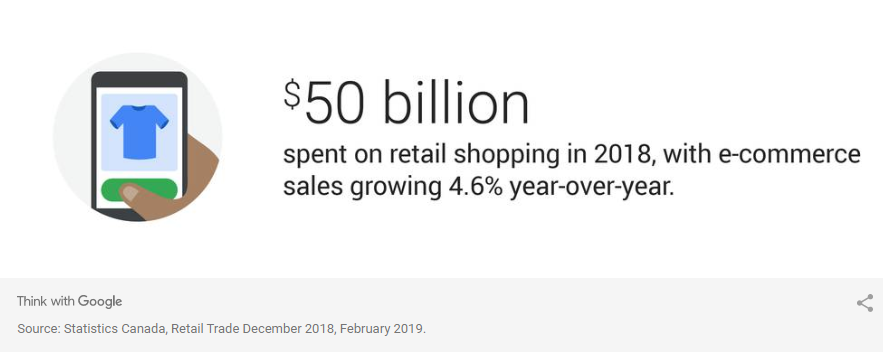
Here’s what you should know about 3 shopper behaviour trends driving this year’s holiday season
Originally posted on the Think With Google blog. Please subscribe sur ce site for more great content!
The holiday season is the most important time of year for a lot of brands. It’s also the most competitive. And thanks to a shorter shopping window between U.S. Thanksgiving and New Year’s Day, the pressure may feel ever greater.
Instead of the 32 shopping days we had last year between U.S. Thanksgiving and New Year’s, we’re looking at only 26 days this year. That’s almost a full week less of peak shopping time.

The silver lining? Overall retail spending is higher than ever, with Canadians spending a record-breaking $50 billion last year.1 And that upswing isn’t just for brick-and-mortar. Retail e-commerce sales were $2 billion in December. On a year-over-year basis, retail e-commerce increased 4.6%.2
If those numbers are a forecast indicator, businesses are likely pinning their hopes on a healthy holiday shopping season. But with so many brands and products competing for a slice of the holiday season pie, it’s more critical than ever for marketers to reach and engage shoppers in key decision-making moments.
To help, we’ve taken an in-depth look at three key behaviors of this year’s shoppers so you can exceed their expectations and have plenty of reasons to celebrate in the new year.
 Holiday shopping trend 1: They’re begging to be inspired
Holiday shopping trend 1: They’re begging to be inspired
Shoppers are making their lists and checking them twice — and they’re heading online for inspiration. Thirty-four percent of Canadian shoppers say that discovering new products and getting ideas are aspects they enjoy most about shopping.3 This is the perfect time for you to be there to inspire these curious shoppers.
And the great news for marketers? Shoppers aren’t just looking for inspiration during the holiday season. They’re searching all the time. In fact, 39% of holiday shopping overall has been completed before the week of Black Friday and Cyber Monday.4 So, while it can be tempting to think that consumer purchasing patterns are consolidated around big days like Black Friday and Cyber Monday, shoppers are on the hunt well in advance of these days and continue to buy just as frequently into the new year.
One way to connect with these ever-curious consumers is to leverage keyword trends throughout the season — not just around two key days. For example, in the U.S., mobile searches for “gift box” have increased over 85% in the past two years, and not just around peak gift-giving days.5 And deals on electronics, which are a Cyber Monday staple, are being sought long before and after the end of November. Mobile searches in the U.S. for “best electric” (for example, best electric toothbrush, best electric shaver) have grown by over 100% in the past two years.6
If you’re hoping to reach these always-on consumers, you may want to redefine your holiday timelines and extend your marketing efforts beyond the standard peak holiday shopping period.
Holiday shopping trend 2: They’re thrill seekers
While some may get a head start on their research, many shoppers hold off hitting the buy button until they know they’ve got the best deal. And for 52% of shoppers, finding a great deal is the most enjoyable thing about shopping.7
Black Friday has traditionally owned the bragging rights for “biggest in-store deal day,” but we’re seeing a shift in consumer thinking. Today, only 1 in 4 shoppers believe that brick-and-mortar stores are giving them the best deals possible. But a majority of shoppers, 52%, believe they’ll get a better deal online.8
People still turn to search first, even if they plan to buy in a store. Around 40% of shoppers from all over the world say they use Google to find the best deals.9 We’ve seen similar trends in keyword searches.
Holiday shopping trend 3: Time is their most valuable asset
There are always folks, 13% of shoppers, in fact, who don’t want to do research.10 They either don’t enjoy, or don’t have time, to embark on a lengthy process. When they want to buy, they want to buy now, and in the easiest and fastest way possible.
But shoppers have other parameters that shape their decision-making. For example, they want flexible options for returns, with 49% of Canadian shoppers factoring in the type of return policy offered before they buy.11 They also prefer a totally autonomous and self-service experience: 43% say they like it when companies make it easy for them to do what they want without having to talk to anyone.12 When you can beat the competition, make sure you show it by highlighting seamless shopping experiences, like easy returns, fast and free shipping, buying online, or in-store pickup.
Are you ready?
There is one constant across these three unique shopping trends. The way people shop around the holiday period is evolving. Brands would be wise to broaden their marketing strategies to incorporate these new behaviors so they don’t miss out on valuable customers — both within and outside peak holiday shopping times.
Originally written by Jane Butler on the Think With Google blog. Please subscribe sur ce site for more great content!

